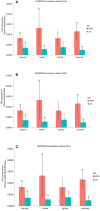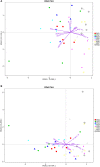Contrasting Soil Bacterial Community, Diversity, and Function in Two Forests in China
- PMID: 30108560
- PMCID: PMC6080587
- DOI: 10.3389/fmicb.2018.01693
Contrasting Soil Bacterial Community, Diversity, and Function in Two Forests in China
Abstract
Bacteria are the highest abundant microorganisms in the soil. To investigate bacteria community structures, diversity, and functions, contrasting them in four different seasons all the year round with/within two different forest type soils of China. We analyzed soil bacterial community based on 16S rRNA gene sequencing via Illumina HiSeq platform at a temperate deciduous broad-leaved forest (Baotianman, BTM) and a tropical rainforest (Jianfengling, JFL). We obtained 51,137 operational taxonomic units (OTUs) and classified them into 44 phyla and 556 known genera, 18.2% of which had a relative abundance >1%. The composition in each phylum was similar between the two forest sites. Proteobacteria and Acidobacteria were the most abundant phyla in the soil samples between the two forest sites. The Shannon index did not significantly differ among the four seasons at BTM or JFL and was higher at BTM than JFL in each season. The bacteria community at both BTM and JFL showed two significant (P < 0.05) predicted functions related to carbon cycle (anoxygenic photoautotrophy sulfur oxidizing and anoxygenic photoautotrophy) and three significant (P < 0.05) predicted functions related to nitrogen cycle (nitrous denitrificaton, nitrite denitrification, and nitrous oxide denitrification). We provide the basis on how changes in bacterial community composition and diversity leading to differences in carbon and nitrogen cycles at the two forests.
Keywords: bacterial community structure; bacterial diversity; bacterial function; environmental factors; temperate deciduous broad-leaved forest; tropical rainforest.
Figures







Similar articles
-
Geographical variation in soil bacterial community structure in tropical forests in Southeast Asia and temperate forests in Japan based on pyrosequencing analysis of 16S rRNA.Genes Genet Syst. 2017 Sep 12;92(1):1-20. doi: 10.1266/ggs.16-00013. Epub 2016 Dec 21. Genes Genet Syst. 2017. PMID: 28003572
-
Environmental Controls on Soil Microbial Communities in a Seasonally Dry Tropical Forest.Appl Environ Microbiol. 2018 Aug 17;84(17):e00342-18. doi: 10.1128/AEM.00342-18. Print 2018 Sep 1. Appl Environ Microbiol. 2018. PMID: 29959251 Free PMC article.
-
Contrasting soil bacterial community structure between the phyla Acidobacteria and Proteobacteria in tropical Southeast Asian and temperate Japanese forests.Genes Genet Syst. 2015;90(2):61-77. doi: 10.1266/ggs.90.61. Genes Genet Syst. 2015. PMID: 26399766
-
[Bacterial community structure and diversity in soils of different forest ages and types in Bao- tianman forest, Henan Province, China].Ying Yong Sheng Tai Xue Bao. 2015 Aug;26(8):2273-81. Ying Yong Sheng Tai Xue Bao. 2015. PMID: 26685588 Chinese.
-
The rhizospheric microbial community structure and diversity of deciduous and evergreen forests in Taihu Lake area, China.PLoS One. 2017 Apr 5;12(4):e0174411. doi: 10.1371/journal.pone.0174411. eCollection 2017. PLoS One. 2017. PMID: 28379996 Free PMC article.
Cited by
-
Soil properties under different ecological restoration modes for the quarry in Yanshan mountains of Hebei province, China.PeerJ. 2022 Nov 18;10:e14359. doi: 10.7717/peerj.14359. eCollection 2022. PeerJ. 2022. PMID: 36420130 Free PMC article.
-
Variation of soil nutrients and bacterial community diversity of different land utilization types in Yangtze River Basin, Chongqing Municipality.PeerJ. 2020 Jul 17;8:e9386. doi: 10.7717/peerj.9386. eCollection 2020. PeerJ. 2020. PMID: 32742767 Free PMC article.
-
Nitrogen addition decreases methane uptake caused by methanotroph and methanogen imbalances in a Moso bamboo forest.Sci Rep. 2021 Mar 10;11(1):5578. doi: 10.1038/s41598-021-84422-3. Sci Rep. 2021. PMID: 33692387 Free PMC article.
-
Response of bacterial community structure to different ecological niches and their functions in Korean pine forests.PeerJ. 2022 Feb 28;10:e12978. doi: 10.7717/peerj.12978. eCollection 2022. PeerJ. 2022. PMID: 35251783 Free PMC article.
-
Carbon Amendments Shape the Bacterial Community Structure in Salinized Farmland Soil.Microbiol Spectr. 2023 Feb 14;11(1):e0101222. doi: 10.1128/spectrum.01012-22. Epub 2023 Jan 10. Microbiol Spectr. 2023. PMID: 36625648 Free PMC article.
References
-
- Ahn C., Peralta R. M. (2009). Soil bacterial community structure and physicochemical properties in mitigation wetlands created in the Piedmont region of Virginia (USA). Ecol. Eng. 35, 1036–1042. 10.1016/j.ecoleng.2009.03.005 - DOI
-
- Bai Z. Z., Yang G., Chen H., Zhu Q. A., Chen D. X., Li Y. D., et al. (2014). Nitrous oxide fluxes from three forest types of the tropical mountain rainforests on Hainan Island, China. Atmos. Environ. 92, 469–477. 10.1016/j.atmosenv.2014.04.059 - DOI
-
- Bastian F., Bouziri L., Nicolardot B., Ranjard L. (2009). Impact of wheat straw decomposition on successional patterns of soil microbial community structure. Soil Biol. Biochem. 41, 262–275. 10.1016/j.soilbio.2008.10.024 - DOI
-
- Bent E., Németh D., Wagner-Riddle C., Dunfield K. (2016). Residue management leading to higher field-scale N2O flux is associated with different soil bacterial nitrifier and denitrifier gene community structures. Appl. Soil Ecol. 108, 288–299. 10.1016/j.apsoil.2016.09.008 - DOI
LinkOut - more resources
Full Text Sources
Other Literature Sources

